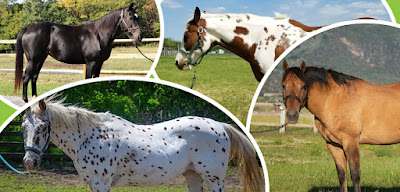Horse Color Genetics - How Many Horse Colors are There
Horses are not just magnificent creatures in terms of strength, speed, and companionship; they also boast a stunning array of colors. These colors are not just a matter of aesthetics but are deeply rooted in the intricate world of horse genetics. Understanding horse color genetics can provide valuable insights into the diversity of these majestic animals. In this article, we will explore the fascinating realm of horse color genetics and delve into the myriad hues that adorn these equine beings.
Basic Genetics:
At its core, horse color genetics involve the interaction of genes that dictate the production of pigments responsible for coat color. The two primary pigments are eumelanin, which produces black and brown colors, and pheomelanin, responsible for red and yellow tones. The combination of these pigments, along with other genetic factors, results in the diverse palette of horse coat colors we observe.
Common Horse Colors: Lets See How Many Horse Colors are There
1. Bay Horse Color: One of the most common colors, bays typically have a reddish-brown body with black points (mane, tail, legs, and ear edges).
2. Chestnut/Sorrel Horse Color: These horses exhibit a solid reddish-brown coat with a matching mane and tail. Chestnut is the term used in the United States, while sorrel is commonly used in other regions.
3. Black: Horses with a solid black coat possess a high concentration of eumelanin, resulting in a uniform color across the entire body.
4. Grey: Grey is an interesting color as horses are not born grey; they gradually lighten with age. A grey horse has a mixture of white and colored hairs.
5. Palomino: Palominos are characterized by their golden coats with a white or light-colored mane and tail.
6. Pinto/Spotted: This category encompasses various coat patterns, including paint, tobiano, and overo, where large, irregular patches of color break up the base coat.
7. Appaloosa: Known for their distinctive spotted coat patterns, Appaloosas often have a white base with dark spots, along with other unique characteristics like mottled skin and striped hooves.
Uncommon and Rare Horse Colors:
1. Dun: Dun horses have a yellow or tan coat with a darker mane, tail, and primitive markings, such as a dorsal stripe and leg barring.
2. Roan: Roan horses have a mixture of white and colored hairs throughout their body, creating a unique, speckled appearance.
3. Buckskin: Similar to palominos, buckskins have a golden coat, but their points are typically black.
4. Champagne: This rare color results in a metallic sheen and dilution of the coat color, often accompanied by light-colored eyes.
Conclusion:
Horse color genetics offer a captivating glimpse into the diversity of coat colors that grace the equine world. From the common bays and chestnuts to the more exotic dun, roan, and champagne, each color is a testament to the intricate dance of genes shaping these majestic creatures. Whether you're an equestrian enthusiast or simply appreciate the beauty of horses, understanding their colors adds a layer of appreciation for the rich genetic tapestry that adorns these remarkable animals.



.jpg)
Comments
Post a Comment